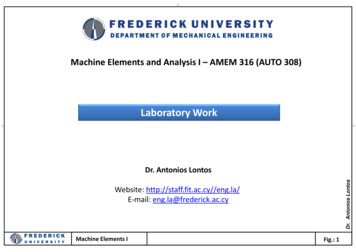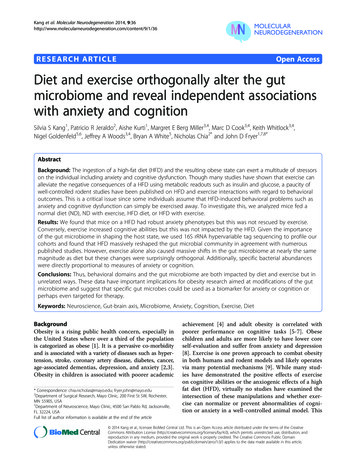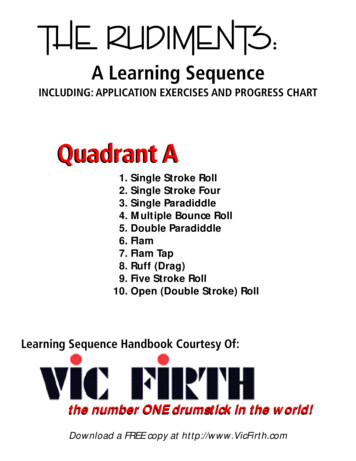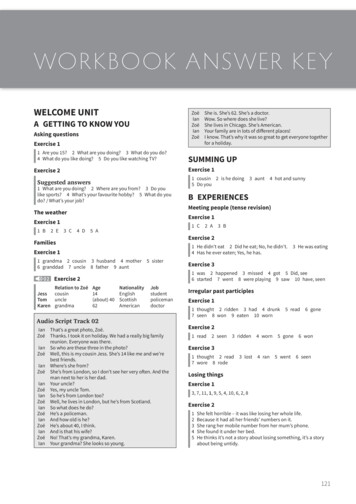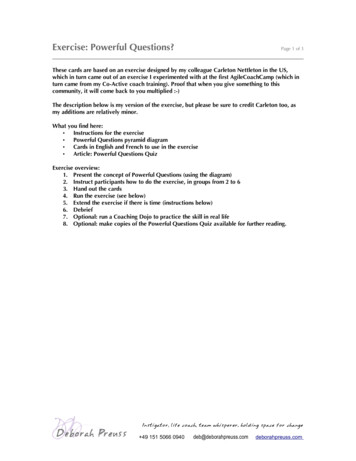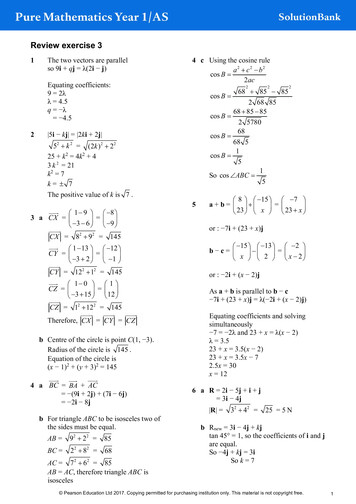
Transcription
Review exercise 31The two vectors are parallelso 9i qj λ(2i j)Equating coefficients:9 2λλ 4.5q λ 4.524 c Using the cosine rulea 2 c2 b2cos B 2ac2 5i kj 2ki 2j 52 k 2 (2k ) 2 2225 k2 4k2 43 k 2 21k2 7k 7The positive value of k is 7 . 1 9 8 3 a CX 3 6 9 CX 82 92 145 1 13 12 CY 3 2 1 CY 122 12 145 1 0 1 CZ 3 15 12 CZ 12 122 145 Therefore, CX CY CZb Centre of the circle is point C(1, 3).Radius of the circle is 145 .Equation of the circle is(x 1)2 (y 3)2 145 4 a BC BA AC (9i 2j) (7i 6j) 2i 8jb For triangle ABC to be isosceles two ofthe sides must be equal.AB BC 22852268229 2 2 8 AC 7 6 85AB AC, therefore triangle ABC isisosceles268 85 85cos B 2 68 8568 85 85cos B 2 578068cos B 68 51cos B 51So cos ABC 552 8 15 7 a b 23 x 23 x or : 7i (23 x)j 15 13 2 b c x 2 x 2 or : 2i (x 2)jAs a b is parallel to b c 7i (23 x)j λ( 2i (x 2)j)Equating coefficients and solvingsimultaneously 7 2λ and 23 x λ(x 2)λ 3.523 x 3.5(x 2)23 x 3.5x 72.5x 30x 126 a R 2i 5j i j 3i 4j R 32 42 25 5 Nb Rnew 3i 4j kjtan 45 1, so the coefficients of i and jare equal.So 4j kj 3iSo k 7 Pearson Education Ltd 2017. Copying permitted for purchasing institution only. This material is not copyright free.1
7f(x) 5x29x100x 100 sin 60 50 3sin 60 f ( x h) f ( x )h5( x h) 2 5 x 2 limh 0h25 x 10 xh 5h 2 5 x 2 limh 0h210 xh 5h limh 0hh(10 x 5h) limh 0h lim(10 x 5h)f'(x) limh 0Using Pythagoras' theorem:y 1002 (50 3) 2 2500 50yor using cos 60 so y 50100m 50 3 30 and n 508 a Call the finish line F:h 0 AF 65i 180j 10i 75i 180jAF 752 1802 38025 195 BF 100i 120j 10i 90i 120jBF 902 1202 22500 150150 195, so boat B is closer to the finishline.b Speed of boat A 2.52 62 42.25 6.5 m/sSpeed of boat B 32 42 25 5 m/sDistanceTime SpeedTime taken for boat A to reach the finish195line 30 s6.5Time taken for boat B to reach the finish150line 30 s5Both boats reach the finish line at thesame time.As h 0, 10x 5h 10x, so f'(x) 10x101y 4 x3 1 2 x 2dy dx ( 4 3x ) 2 12 x2 12 1 2dy 12 x 2 xdxOr:dy1 12 x 2 1dxx2Or:dy1 12 x 2 dxx3211 a y 4 x 3 x 2 x 21 dy ( 4 1x 0 ) 3 32 x 2 ( 2 2 x1 )dx 1dy 4 92 x 2 4 xdxb For x 4,3 y ( 4 4 ) 3 4 2 ( 2 42 ) 16 ( 3 8 ) 32 16 24 32 8So P (4, 8) lies on C. Pearson Education Ltd 2017. Copying permitted for purchasing institution only. This material is not copyright free.2
11 c For x 4,1 dy4 92 4 2 ( 4 4 ) dx 94 ( 2 2 ) 16 4 9 16 3This is the gradient of the tangent.The gradient of the normal at P isThe normal is perpendicular to the1tangent, so the gradient is .mEquation of the normal:1y 8 ( x 4 )3x 4y 8 3 33 y 24 x 43 y x 20120 yx 33( 4 20 ) (8 0 )22242 82 576 64 640 64 10 8 1012 ac 0 3x 5y 0 : 3 5x 53So k 5313 a f ( x ) ( 2 x 1)( x 4 )x2x 9x 4 x23212 2x 9x 4xP 2, Q 9, R 4 d y 0:0 x 20x 20Q is the point ( 20, 0).PQ 1.3dy12 b At x 1, 3dxdyThe value ofis the gradient of thedxtangent.5 1At x 1, y ( 4 12 ) 1y 4 4 8Equation of the tangent:y – 8 3(x 1)y 3x 55 xx2 4 x 5 x 1 1 y 4x2 dy ( 4 2 x1 ) ( 5 x 1x 2 )dxdy 8 x 5 x 2dxAt P, x 1, sody ( 8 1) ( 5 1 2 )dx 8 5 3b 1211 f ' ( x ) 2 32 x 2 9 12 x 2 3 12 4 2 x 1f ' ( x ) 3 x 2 92 x 12 2x 32c At x 1,113 f ' (1) 3 12 92 1 2 2 1 2 9 3 2 2 112The line 2y 11x 3 is y 112 x 32 The gradient is 112 .The tangent to the curve where x 1 isparallel to this line, since the gradients areequal. Pearson Education Ltd 2017. Copying permitted for purchasing institution only. This material is not copyright free.3
14f(x) x3 12x2 48xf'(x) 3x2 24x 48 3(x 4)2(x 4)2 0 for all real values of xSo 3x2 24x 48 0 for all real values ofx.So f(x) is increasing for all real values ofx.15 a y x 2 3x2 3 0xx2 2 3x 0x2 3x 2 0(x 1)(x 2) 0x 1 or x 2When y 0, x A(1, 0) and B(2, 0)b y x 2 x 1 3dy 1 2 x 2dx2 1 2xLet16Draw a diagram. Let h be the height of thecylinder.a Surface area,S 2π rh 2π r 2 Volume π r 2 h 128π128πh π r2128 2r128so S 2π r 2 2π r 2r256π 2π r 2 ( as required )rds256πb 4π r 2drr256π4π r 2 0r256π4π r 2r3r 64r 4 cmWhen r 4,256π2S 2π ( 4 )( 4) 64π 32πdy 0 to find the minimumdxx2 2x 2x is positive, so x 2 .When x 2 ,2y 2 32 96π cm 217 a y 3x 2 4 x1 3x 2 4 x 2 1 12 dy1 (3 2x ) 4 x dx 2 1 dy 6x 2x 2dxOr :2dy2 6 x 1 6 x dxxx22 2 32 2 2 3 2 C has coordinates ( 2 , 2 2 3 )16b 1dy 6x 2x 2dx d2 y1 32 6 2 x dx 22 3 6 x 2 Pearson Education Ltd 2017. Copying permitted for purchasing institution only. This material is not copyright free.4
17 bOr:2d y1 6 32dxx2Or :19 138 13x x dx182 4 43 x 3 23 x 3 1d2 y1 6 2dxx x4242 43 ( 8 ) 3 23 ( 8 ) 3 43 (1) 3 23 (1) 3 3333 ( 4 (16 ) 2 ( 4 ) ) ( 4 (1) 2 (1) )32743 641 3x3 4 x 2c 3 x 2 4 x 2 dx 3 C3(2) 3x3 4 ( 23 ) x 2 C 3 x3 83 x 2 C( Or : x3 83 x x C)18 a f ' ( x ) 6 x 2 10 x 126 x3 10 x 2 12 x C32When x 5, y 65, so:6 125 10 25 60 C653265 250 125 60 CC 65 125 60 250C 0f ( x) f ( x ) 2 x3 5 x 2 12 xb f ( x ) x ( 2 x 2 5 x 12 )f ( x ) x ( 2 x 3)( x 4 )c Curve meets x-axis where y 0x ( 2 x 3)( x 4 ) 0x 0, x 32 , x 4When x , y When x , y Crosses x-axis at ( 32 , 0 ) , ( 0, 0 ) and ( 4, 0 ) .20 6( x 2 kx) dx06 x3 kx 2 2 0 3 63 k (6) 2 03 k (0) 2 2 32 3 72 18kGiven that 72 18k 0k 460( x 2 kx) dx 021 a x4 3x2 4 0( x2 4)(x2 1) 0(2 x)(2 x)(x2 1) 0x2 1 0 has no real solutions.So there are two solutions x 2 or x 2.A( 2, 0)and B(2, 0)b R 2 2( x 4 3 x 2 4) dx2 x5 3x3 5 3 4x 22 x5 x3 4 x 5 25 2 23 4(2) 5 ( 2)5 ( 2)3 4( 2) 5 32 32 8 8 8 8 5 5 2 19.2 units Pearson Education Ltd 2017. Copying permitted for purchasing institution only. This material is not copyright free.5
22Area 4 ( x 1)( x 4 ) dx x 5 x 4 dx14 214 x3 5 x 2 4x 2 3 1 ( 4 )3 5 ( 4 ) 2 4 ( 4) 2 3 (1)3 5 (1)2 4 (1) 3 2 1 42 Area 4 12 units2 (area cannot be anegative value)23 a Solving simultaneously5 x2 3 xx2 x 2 0(x 2)(x 1) 0x 2 or x 1when x 2, y 1when x 1, y 4P( 1, 4) and Q(2, 1)b Shaded area area under the curve between P and Q andthe x-axis area of trapezium21Area (5 x 2 ) dx 3(1 4) 122 x3 15 5 x 3 1 2 23 ( 1)3 15 5(2) 5( 1) 3 3 2 8 1 15 10 5 3 3 2 2 4.5 units24 a k 1At point A, x 0f(x) 3e0 1 2A(0, 2) The y-coordinate of A is 2.24 b At point B, y 03e x 1 03e x 1e x 13ln (e x) ln 13 x ln 13x ln 13 ln ( 13 ) 1 ln 3 (which is the x-coordinateof B)25T 400e 0.05t 25, t 0a let t 0T 400 e0 25 425 Cb let T 300 300 400e 0.05t 25300 25 400e 0.05t275 400e 0.05t275 e 0.05t400Take ln of both sides: 275 ln 0.05t 400 1 275 ln t0.05 400 t 7.49 minutesc T 400e 0.05t 25 dT 400e 0.05t 0.05dt 20e 0.05tlet t 50dT 20e 0.05t 50dt 20e 2.5 1.64The rate the temperature is decreasing is1.64 C/mind T 400e 0.05t 25, t 0e 0.05t tends to 0, so effectively theminimum value of T is 25 C. Therefore,20 C is not possible. Pearson Education Ltd 2017. Copying permitted for purchasing institution only. This material is not copyright free.6
25 e In the given model, the temperature after along period of time is 25 .Replace 25 with 15 to give:T 410e–0.05t 15, t 028 a log p ( 126 ) log p 2b log 4 x 1.54 1.5 x26 a 5 x 0.75x log 5 log 0.75x 18 or 0.125log 0.75log 5x 0.179x 29 a ln x ln 3 ln 6ln 3 x ln 63x 6x 2b 2 log 5 x log 5 3 x 1log 5 x 2 log 5 3 x 1b x2 log 5 1 3x x2 x 51 3x 3x 1527 a 3 10(2 x 1) log 3 log10log102x 1 log 312 x 1log 3e 2 x 4e x 3 0let y e x2 x 1x (log10 1) 1 1 1 2 log 3 0y2 4 y 3 ( y 3)( y 3) 0y 3 or 1y ex e x 3 or e x 1x 0 x ln 3 or x 030 a 1.55b log 2 x log 2 (9 2 x) 2log 2 x(9 2 x) 2 4 9x 2x22x2 9x 4 0(2 x 1)( x 4) 028 a log p 12 (12Time in years since 1970, t log P010203040 22 x(9 2 x) xe x 3e x 43ex x 4ee2 x 3 4e x0.770.881.011.141.29b or x 412log p 9 13 log p 8 )(11 log p 12 log p 9 2 log p 8 3 log p 12 ( log p 3 log p 2 )) log p 12 ( log p (3 2) ) log p 12 log p 6 Pearson Education Ltd 2017. Copying permitted for purchasing institution only. This material is not copyright free.7
30 c As P abtlog P log (abt)log P log a log btlog P log a t log bThis is a linear relationship where thegradient is log b and the intercept is log a.d Intercept 0.77log a 0.77a 100.77 5.888. 5.9 (2 s.f.)0.521.29 0.77 0.0134040 0log b 0.013b 100.013 1.03. 1.0a 5.9, b 1.0Gradient 31 alog 2 log x log y log( x y )log 2 x log y log( x y )log 2 x log y log( x y )2xlog log( x y )y2x x yyx xy y 22 y22 x xy x(2 y ) y2y2x 2 yb0 y 2y 0 given.x 0 also given, and y2 0, so 2 – ymust be 0. Hence y 2. Note strictinequality because denominator cannotbe 0.Challenge1 a 090 means sin θ 0Therefore, θ 02 a f'( 3) k(( 3)2 3 6) 0f'(2) k(22 2 6) 0Using the factor theorem, x 3 and x 2are factors of f'(x).So f'(x) k(x 3)(x 2) k(x2 x 6)As f(x) is cubic, there are no other factorsof f'(x).b k(x2 (kx x 6) dx 2 kx 6k ) dxkx3 kx 2 6kx c32At ( 3, 76)k ( 3)3 k ( 3) 2 6k ( 3) c 76329k 9k 18k c 76227 k c 762At (2, 49)k (2)3 k (2) 2 6k (2) c 49328k 2k 12k c 49322k c 493Solving27 k c 76 and222k c 49 simultaneously327 k22kand c 49 c 76 3227 k22kSo 76 4923456 81k 44k 294125k 750k 6, c 5kx 3 kx 2f(x) 6kx c326 x3 6 x 2 6(6) x 532 2x3 3x2 36x 5 b cos θ 1So the vector is 1iMagnitude 12 02 1 Pearson Education Ltd 2017. Copying permitted for purchasing institution only. This material is not copyright free.8
3 9090f ( x) dx 24.2(f ( x) 3) dx [ f '( x) 3 x ]09 ( f '(9) 3(9) ) (f '(0) 3(0)) 90f ( x) dx 27 24.2 27 51.24 a f(0) 03 k(0) 1 1g(0) e2(0) e0 1Therefore, f(0) g(0) 1P(0, 1)b f'(x) 3x2 kGradient at x 0f'(0) 3(0)2 k kGradient of g(x) at x 0 isg'(x) 2e2xg'(0) 2e2(0) 2e0 21 2k1k 21k Pearson Education Ltd 2017. Copying permitted for purchasing institution only. This material is not copyright free.9
AB 92 85 2 2 . BC 28 68 . AC 7622 85 AB AC, therefore triangle ABC is isosceles . 4 c Using the cosine rule . 22 2 cos 2 a cb B ac 2 22 68 85 85 cos 2 68 85 B 68 85 85 cos 2 5780 B 68 cos 68 5 B 1 cos 5 B So . 1 cos 5 ABC. 5 a b 8 15 23 x 7 23x or : 7i (23 x)j. b. . c .

